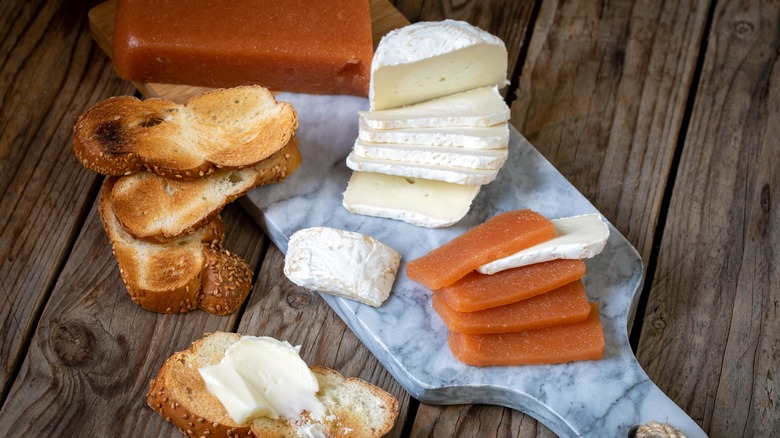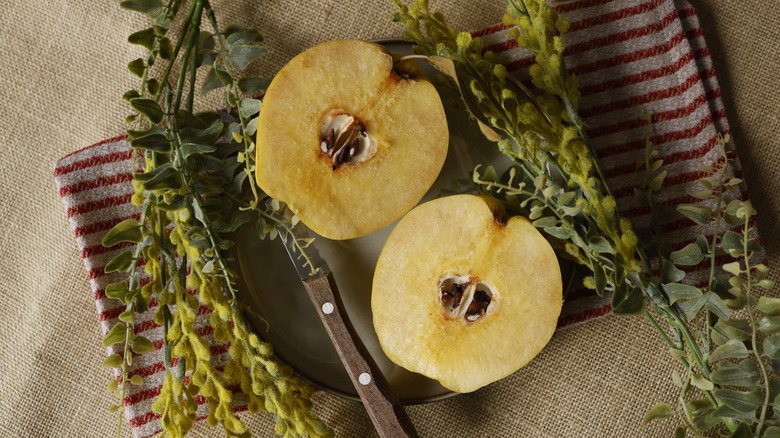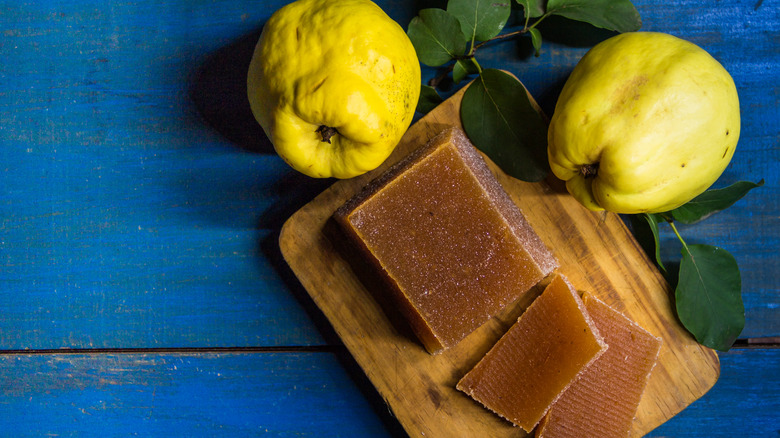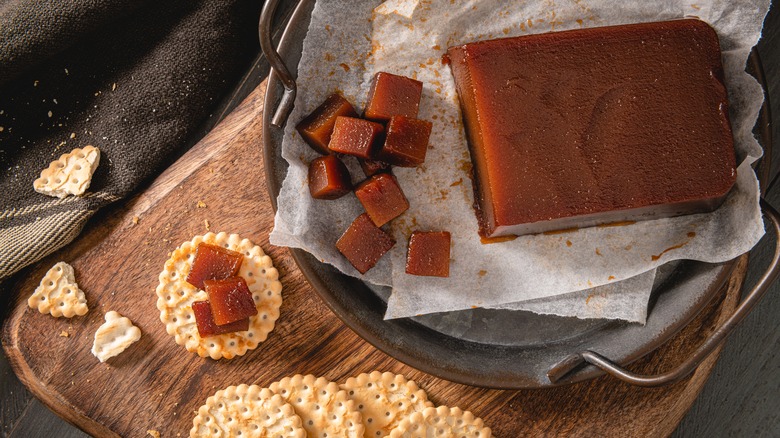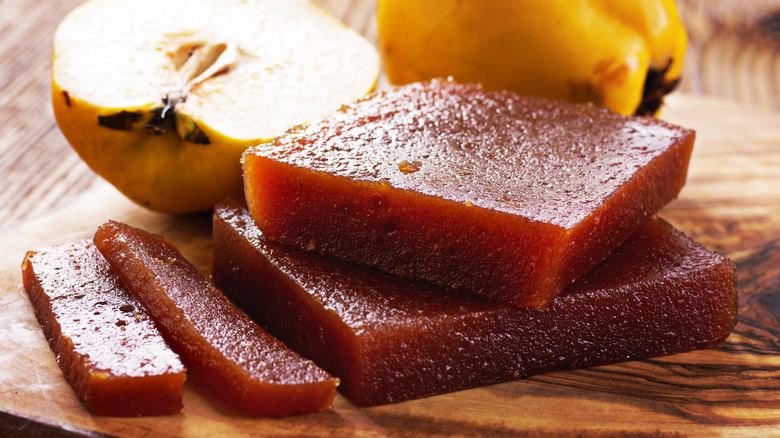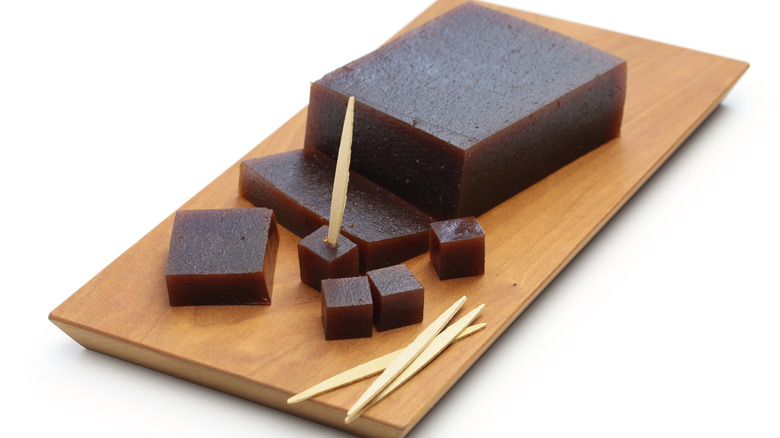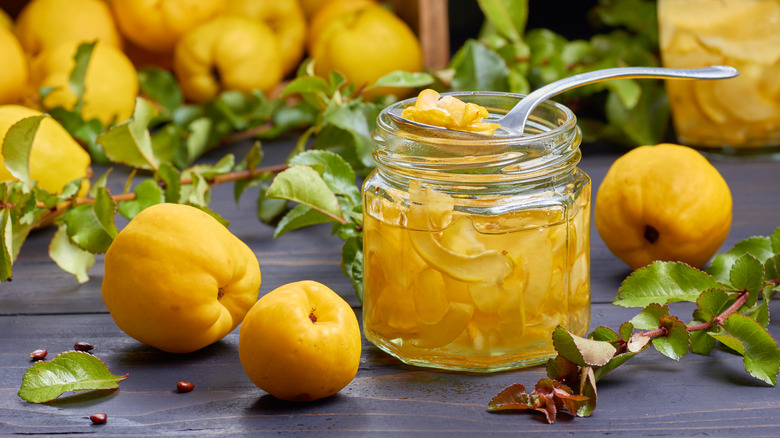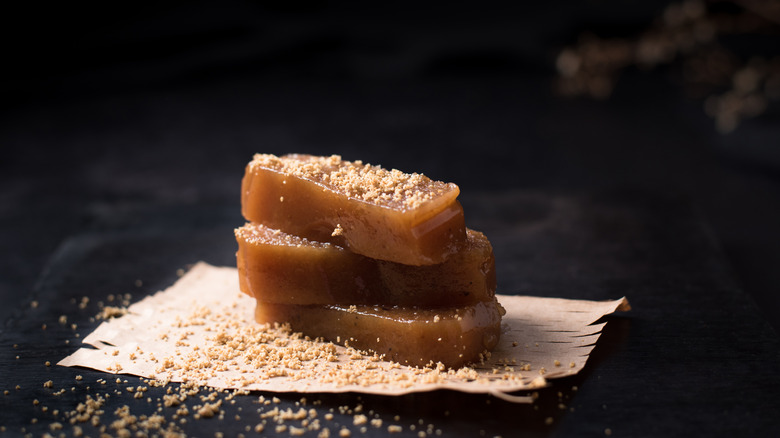Quince Paste Is The Fruity Addition For A Fancier Charcuterie Board
There's no one way to build a beautiful cheese or charcuterie board, from the meats and cheeses you select to the spreads and other accompaniments you pair with them. Jams and fruits are common additions to charcuterie boards because they help balance the rich and savory flavors that dominate the plate. While the standard pairings of fresh grapes or fig jam are always delicious, there are plenty of other options to shake up the flavors.
Quince paste is a less common ingredient, but it makes a perfect addition to any charcuterie board. It's a thick, fruity paste with a sweet yet tart zing that wonderfully complements rich cured meats and fine cheeses. If you're curious about this ingredient and wondering how to incorporate it into your next charcuterie board, don't worry. Here is everything you need to know about quince paste, from what it tastes like to how it's made and even where to find it.
What is quince paste?
Quince paste is a fruit spread that's typically thicker and more stable than jam but still soft and sweet. As the name suggests, it's made from quince, aka Cydonia oblonga, which is a pome fruit that looks a lot like the baby of an apple and a pear but is its own distinct fruit. They ripen in the late months of fall and are typically a beautiful, bright golden-yellow color.
Quince paste is a way of preserving the fresh, ripe yields of quince fruit. It's popular in many Mediterranean countries, including Spain, where it is called dulce de membrillo. It's commonly paired with cheeses and charcuterie, with manchego cheese being one of the most common picks. Rather than being jammy and spreadable, quince paste more closely resembles a fruit pâté. It often comes in a square or rectangular package and can easily be sliced into smaller pieces for serving.
How is quince paste made?
After peeling the fruit and removing the seeds, Quince paste is typically made by stewing the pulp of the fruit with sugar and water, then formed into a paste, though it can also be made in a pressure cooker. After being blended into a puree, the jam-like liquid is reduced until it becomes extremely thick. The paste is then chilled and dried in the form of a solid block.
As the quince is cooked and reduced, it develops a richer, darker color that's more reddish than the golden hue of the uncooked fruit. On its own, quince is firm and tart. The cooking softens the fruit, and the added sugar makes for a fruit paste that is pleasantly sweet. While pressure cooking is a common preparation method, the quince fruit can also be cooked down in water for a longer period of time (an hour or two) in a standard stovetop pot for a similar result. Quince paste is made in industrial and professional kitchens to be sold in stores, but it is also fairly easy to make at home if you're able to find fresh quince fruit.
Quince paste vs fresh quince
There's a reason why you don't see fresh quince on the side of any charcuterie boards. Since this native Southwest Asian fruit is now grown in many parts of the world, including the northeastern United States, it can be difficult but not impossible to find fresh quince at the grocery store. The biggest reason why fresh quince doesn't appear on charcuterie boards, however, is that the fruit is rather hard, tart, and even slightly bitter. Unlike the juicy bite of an apple or pear, quince is tough and unpleasant to eat raw because of both its texture and flavor.
That's why quince paste is the more popular form of the fruit. This method of preparation tenderizes the fruit, and the added sugar does wonders for the flavor. Having a slice of quince paste with your manchego cheese is far more pleasant than biting into a raw piece of quince fruit. Quince paste is not the only method of preserving and making quince fruit tastier. Quince jam is not uncommon and is just as tasty when paired with cheeses and charcuterie, but the texture is different. Quince jam is not reduced as much as the paste, nor is it dried into a block, making it more liquidy and spreadable. Quince paste is a firm jelly that holds its shape even when sliced into pieces.
What does quince paste taste like?
Because the fruit is naturally tart, quince paste still maintains some of that tartness, even after being reduced with sugar. While many claim it tastes a bit like apple or pear, quince paste has its own distinct flavor. There's acidity and tartness along with subtle floral notes that complement the sweetness from the added sugar. The flavor and texture of quince paste can be reminiscent of guava paste. Quince paste is sweet, but not like candy. The sugar largely helps to tame the bitterness and tartness of the raw fruit. This combination of tart and sweet is part of what makes this ingredient pair so well with charcuterie and cheese.
The texture of quince paste is firm but not chewy. It has a soft bite, though it holds its shape and is not spreadable, syrupy, or liquidy like a jam. There is a slight graininess to the paste, though it is not unpleasant or tough. It's not unlike the texture of a ripe pear.
How to cook with quince paste
Quince paste can be used in a variety of ways. The most traditional way to eat it is alongside slices of manchego cheese, but it pairs well with other cheeses, too. Quince paste is not quite as rich or heavy as fig jam, which is commonly paired with cheese and charcuterie as well. This makes the quince paste more versatile as it can pair with milder cheeses like manchego, of course. But the flavor is strong enough and sweet enough that it won't get lost next to a funky blue cheese or a rich and salty slice of cured meat.
Aside from accompanying a variety of cheeses and cured meats, it's also fairly common for quince paste to be used in baking. You can use the paste to fill pastries and tarts or even use it for a sweet and savory combo on roasted meats, like lamb.
Where to buy quince paste
Not just an Asian or European treat, quince paste can be found at U.S. grocery stores, but that doesn't mean it's available everywhere. The best places to look for high-quality versions of this ingredient are small cheese or charcuterie specialty shops or at local grocers that source fine imported foods.
If you're searching for quince paste on your regular grocery trip, check the cheese aisle and the specialty cheese section in particular if your local store has one. It's often found next to other cheese and charcuterie accouterments, like crackers, fig jams, olives, or specialty almonds. It can also be found at chain retailers that are known for stocking unique food items, like World Market.
Quince paste can also be found quite easily online if you're struggling to find it anywhere near you in person. Some small specialty retailers will offer shipping for online purchases, and it can even be found on Amazon.
Nutritional information about quince paste
Quince, like many other fruits, is rich in vitamins and minerals. It's particularly high in vitamin C, and is chock full of copper, B vitamins, potassium, iron, and magnesium. Because of this, many of these minerals and vitamins are also found in quince paste. Raw quince is also high in fiber, though there is slightly less fiber in quince paste since the fruit is peeled before being reduced.
While there are plenty of vitamins, minerals, and natural fibers in quince paste, there is also a decent amount of sugar. For example, Murray's brand quince paste, which can be found in many grocery stores, has 16 grams of sugar per one ounce of paste. While the ingredients of most quince pastes are simple (Murray's is just quince and sugar), it's good to remember that the added sugar is not as nutritional as the pulp of the quince fruit itself, so indulge in moderate servings to avoid excess sugar intake.
Varieties of quince paste
Most quince paste varieties on the market are quite similar given that the primary ingredients are simply quince and sugar, though some recipes also call for a hint of lemon. Quince is naturally high in pectin, which would otherwise have to be an added ingredient to stabilize the paste. Most brands of quince paste are more or less exactly the same.
You can also find quince jelly, which is made from quince fruit, too, but is not the same as membrillo, or quince paste. While quince paste is made with the pulp of the fruit, quince jelly is made from the juice that's extracted during processing. Quince jelly omits the pulp altogether by straining the cooked quince and turning the clear liquid into a jelly. Quince jelly has a similar flavor but a totally different texture. For cheese and charcuterie boards, opt for the more textured and firm quince paste.
How to store quince paste
Quince paste should ideally be stored in the refrigerator. Some store-bought versions are shelf-stable for a time as long as they're unopened. But, once it's been opened, or if you make homemade quince paste, it should be stored in the fridge. In order to prevent the paste from drying out too much, keep it in an airtight container or wrap it tightly in plastic wrap. Quince paste can last for up to a few months in the fridge without spoiling.
If you'd like to keep your quince paste around for a little longer, you can also freeze it. Quince paste will keep in the freezer for up to a year for you to thaw and enjoy at any time. Like most foods, it may taste a bit better if kept in the fridge and eaten sooner, but overall, quince paste stores quite well and will still taste delicious whether it's been in the fridge for a month or the freezer for nine.
